

China’s New Tactic to Prevent the Spread of Covid-19? Cash and Gifts. 2021 01 21 wuhan anniversary TEN. A Timeline of China's Response in the First Days of COVID-19. The FRONTLINE documentary China’s COVID Secrets tells the story of the beginning of the coronavirus pandemic that would overtake the world, and how Chinese doctors, scientists, health officials and political leaders responded.

Here, we highlight some of the key moments in the earliest days of the outbreak. The city of Wuhan. December 1, 2019 A man in his 70s starts experiencing symptoms. He is later admitted to a hospital in Wuhan, China. Huanan Seafood Market. Mid-December, 2019 People begin turning up at hospitals in Wuhan with strange white spots on their lung scans. December 24, 2019 A sample is taken from a Wuhan Central Hospital patient’s lungs and sent to Vision Medicals, a private company 500 miles from Wuhan that produces a partial genetic sequence of the virus within 48 hours. A lung scan of a COVID-19 patient. The lab goes on to inform the Wuhan Central Hospital doctors and the city’s CDC. Wuhan Central Hospital. More virus samples are sent to other labs for sequencing. China's COVID Secrets (full documentary) Recordings Reveal WHO Concerns About China's Early COVID Response.
As World Health Organization officials publicly praised China in the critical early weeks of the outbreak of what would come to be known as COVID-19, they privately expressed concern about the government’s lack of transparency and worried that the WHO would be accused of failing to warn the world.

The revelation comes in leaked recordings obtained by the Associated Press and shared with FRONTLINE that are heard in the upcoming FRONTLINE documentary China’s COVID Secrets, a coproduction with the BBC. “We’ve all been, or some of us, we’ve been here before, in 2003 [during the SARS outbreak],” Dr. Michael Ryan, who was overseeing the WHO’s response to the emerging outbreak, says in a leaked recording from early January 2020. “This is exactly the same scenario. Endlessly trying to get updates from China. … The danger now, despite our good intent … especially if something happens … there will be a lot of finger-pointing.”
The Economist Asks: Hao Wu - What happened in Wuhan? A YEAR ago the Chinese city of 11 million people cut itself off to contain the spread of a deadly virus.

Hao Wu, the director of "76 Days" a documentary about the Wuhan lockdown, talks to Anne McElvoy about the first casualties, life under quarantine and the personal impact of covid-19. Why did Hao Wu avoid politics in the film and why has he been trolled for making it? Also The Economist's Beijing bureau chief, and Chaguan columnist David Rennie, on how Chinese people's view of democracy has been eroded by the virus. Runtime: 27 min Listen on: Apple Podcasts | Spotify | Google | Stitcher | TuneIn. Chaguan - Many in China are strikingly accepting of harsh virus controls. ON JANUARY 10th an office worker surnamed Zhou was diagnosed with covid-19 in Xicheng, a district of Beijing.
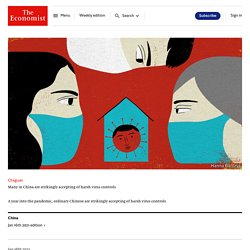
For officials under orders to keep the virus out of China’s capital, this single case was grim, career-threatening news. They responded with a vigour that some other countries reserve for wartime invasions. As is the norm when anyone in China tests positive, Ms Zhou’s movements for the previous ten days were made public, down to noodle bars where she ate and train lines that she took. Internet users fumed that she had twice visited Shijiazhuang, a drab city of 11m people in the next-door province of Hebei, which has seen more than 400 virus cases since the new year. She should have stayed at home, or at least avoided the metro, netizens growled. Almost 100 of Ms Zhou’s close contacts and thousands of workers near her office were swiftly tested. Teaching About Asia in a Time of Pandemic - Association for Asian Studies.
Thanks to generous support from the Henry Luce Foundation, we are pleased to make this important and timely Asia Shorts collaborative volume available as open access.
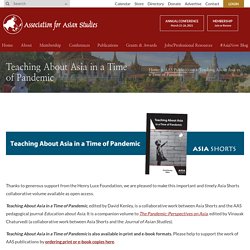
Teaching About Asia in a Time of Pandemic, edited by David Kenley, is a collaborative work between Asia Shorts and the AAS pedagogical journal Education about Asia. It is a companion volume to The Pandemic: Perspectives on Asia, edited by Vinayak Chaturvedi (a collaborative work between Asia Shorts and the Journal of Asian Studies). Teaching About Asia in a Time of Pandemic is also available in print and e-book formats. Please help to support the work of AAS publications by ordering print or e-book copies here. Did half a million people in Wuhan contract the coronavirus? She Chronicled China’s Crisis. Now She Is Accused of Spreading Lies.
In one video, during the lockdown in Wuhan, she filmed a hospital hallway lined with rolling beds, the patients hooked up to blue oxygen tanks.
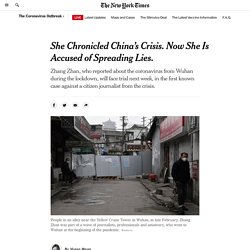
In another, she panned over a community health center, noting that a man said he was charged for a coronavirus test, even though residents believed the tests would be free. At the time, Zhang Zhan, a 37-year-old former lawyer turned citizen journalist, embodied the Chinese people’s hunger for unfiltered information about the epidemic. Now, she has become a symbol of the government’s efforts to deny its early failings in the crisis and promote a victorious narrative instead.
Ms. Zhang abruptly stopped posting in May, after several months of dispatches. Then there are the paid commenters. Hundreds of thousands of low level gov’t employees are ordered by officials to post positive comments online. They use specialized software to command large numbers of accounts and mass post. Here’s a guide to what they.
Translation: Recommendations for Handling Netizen Reaction to Li Wenliang’s Death. Dr.
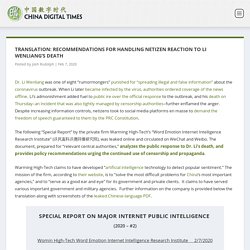
Li Wenliang was one of eight “rumormongers” punished for “spreading illegal and false information” about the coronavirus outbreak. When Li later became infected by the virus, authorities ordered coverage of the news offline. Li’s admonishment added fuel to public ire over the official response to the outbreak, and his death on Thursday–an incident that was also tightly managed by censorship authorities–further enflamed the anger.
Despite increasing information controls, netizens took to social media platforms en masse to demand the freedom of speech guaranteed to them by the PRC Constitution. The following “Special Report” by the private firm Warming High-Tech’s “Word Emotion Internet Intelligence Research Institute” (沃民高科沃德网情研究院), was leaked online and circulated on WeChat and Weibo. Warming High-Tech claims to have developed “artificial intelligence technology to detect popular sentiment.” Qi is dubbed as an expert in public opinion management. How China Censored Covid-19. This article is copublished with ProPublica, the nonprofit investigative newsroom.
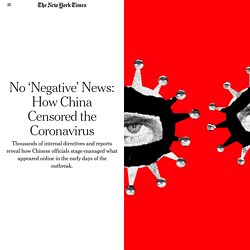
In the early hours of Feb. 7, China’s powerful internet censors experienced an unfamiliar and deeply unsettling sensation. They felt they were losing control. The news was spreading quickly that Li Wenliang, a doctor who had warned about a strange new viral outbreak only to be threatened by the police and accused of peddling rumors, had died of Covid-19. Grief and fury coursed through social media. China testing blunders stemmed from secret deals with firms.
WUHAN, China (AP) — In the early days in Wuhan, the first city struck by the virus, getting a COVID test was so difficult that residents compared it to winning the lottery.

Throughout the Chinese city in January, thousands of people waited in hours-long lines for hospitals, sometimes next to corpses lying in hallways. But most couldn’t get the test they needed to be admitted as patients. Checking In on China’s Post-Pandemic Middle Class. When I asked Christine, a 40-something Shanghai native with a degree from a top university, a job in the tourism industry, and a home in the city, how the COVID-19 pandemic had impacted her place in China’s middle class, she quickly corrected me.

“I have never perceived my family to be part of the middle class,” she said. “When I hear ‘middle class,’ I think of my clients. They have more money from their own companies or their jobs as skilled professionals or managers in large enterprises. My husband and I both work in the service industry; it’s very fragile.” Christine’s response reflects public perceptions of the middle class in China, which are heavily influenced by TV dramas, novels, commercials, and other mass culture products that depict businesspeople, managers, and intellectual elites with very high incomes as “middle class.” That includes Christine and her husband — another local Shanghainese with an prestigious degree. However, Christine did have a point. How China Controlled the Coronavirus. The school scheduled regular hand-washing breaks, and every afternoon an announcement sounded over the intercom: “Temperature-taking time has arrived!” Each day, my daughters had their temperature taken at least five times.
This routine began at 6:30 A.M., when the class’s WeChat parent group engaged in something called Jielong, or “Connect the Dragon.” One parent would start the hashtag #Jielong, and list her child’s name, student number, temperature in Celsius, and the words “Body is healthy.” One by one, other parents jumped in—“36.5, Body is healthy”—lengthening the list with every dragon link. My account usually had about sixty of these messages every day. The Stress Test: Waiting for ‘Gaokao’ Zoey Liu, a senior student at a top-notch high school in Beijing, didn’t think COVID-19 would flare up again. The fact that it’s reappeared less than a month before the gaokao, China’s grueling college entrance examination, has only made matters worse. “I didn’t take it seriously when I heard about the first new case and thought it was under control,” Liu tells Sixth Tone. “But now I know I underestimated the severity of the second wave.” Since June 11, Beijing has identified 329 new cases as of Wednesday.
How Civic Technology Can Help Stop a Pandemic. The spread of the novel coronavirus and the resulting COVID-19 pandemic have provided a powerful test of social and governance systems. Neither of the world’s two leading powers, China and the United States, has been particularly distinguished in responding.
In China, an initial bout of political denial allowed the virus to spread for weeks, first domestically and then globally, before a set of forceful measures proved reasonably effective. (The Chinese government also should have been better prepared, given that viruses have jumped from animal hosts to humans within its territory on multiple occasions in the past.) Telling China’s Covid-19 Story. Xi Jinping has emphasized on numerous occasions that the Chinese Communist Party must “tell the China story well.”
The notion of the “China story,” which dates back to a high-level internal meeting on propaganda and ideology in August 2013, has come to encapsulate the Party’s conviction that it must redress global imbalances in “discourse power,” or huayuquan (话语权), that favor the West and impact China’s fundamental interests internationally. In March 2019, Xi spoke of “an historic opportunity for Party-led media” to press China’s agenda more actively in the world. “We must strengthen our capacity, boost morale and persevere in telling the China story,” he said, “creating international discourse power befitting our country’s comprehensive national power.”
China delayed releasing coronavirus info, frustrating WHO. Throughout January, the World Health Organization publicly praised China for what it called a speedy response to the new coronavirus. It repeatedly thanked the Chinese government for sharing the genetic map of the virus “immediately,” and said its work and commitment to transparency were “very impressive, and beyond words.” But behind the scenes, it was a much different story, one of significant delays by China and considerable frustration among WHO officials over not getting the information they needed to fight the spread of the deadly virus, The Associated Press has found. Despite the plaudits, China in fact sat on releasing the genetic map, or genome, of the virus for more than a week after three different government labs had fully decoded the information. Tight controls on information and competition within the Chinese public health system were to blame, according to dozens of interviews and internal documents.
China Pushes for Quiet Burials as Coronavirus Death Toll Is Questioned. Liu Pei’en held the small wooden box that contained his father’s remains. Only two months ago, he had helplessly clutched his father’s frail hand as the elderly man took his last breath, and the pain was still raw. He wept. But there was little time, or space, for Mr. Liu to grieve. Global Backlash Builds Against China Over Coronavirus. Corona: China versucht, deutsche Beamte zu Lob zu drängen. Peking setzt Diplomaten auf deutsche Regierungsmitarbeiter mit einer speziellen Mission an. Wie nun bekannt wird, haben Vertreter der Volksrepublik Beamte und Mitarbeiter deutscher Bundesministerien kontaktiert, damit sich diese positiv über das Coronavirus-Management der Volksrepublik äußern. Nach Informationen von WELT AM SONNTAG hat das Auswärtige Amt im März in einem Schreiben andere Ministerien darüber informiert, dass es zu entsprechenden Anfragen von chinesischer Seite gekommen sei.
Das deutsche Außenministerium gab eine eindeutige Handlungsempfehlung: Jenen Anfragen soll nicht entsprochen werden. Das Auswärtige Amt wollte auch nach mehrmaliger Nachfrage den Sachverhalt weder kommentieren noch dementieren. Exklusiv für Abonnenten. China’s ‘Donation Diplomacy’ Raises Tensions With U.S. WASHINGTON — When President Trump spoke with Xi Jinping, the Chinese leader, late last month to reach a truce to the sniping over the coronavirus pandemic, he did so partly to pave the way for steady shipments of much-needed medical supplies from China. Shipments have run into unexpected delays as Chinese officials impose new regulations in response to complaints of low-quality products. And some American officials remain reluctant to accept gifts of gear because they fear giving the Chinese Communist Party a propaganda win.
Exclusive: She's been falsely accused of starting the pandemic. Her life has been turned upside down. The false claims are spreading across YouTube every day, so far racking up hundreds of thousands of apparent views, and have been embraced by Chinese Communist Party media. Despite never having tested positive for the coronavirus or experienced symptoms, Benassi and her husband are now subjects of discussion on Chinese social media about the outbreak, including among accounts that are known drivers of large-scale coordinated activities by their followers.
The claims have turned their lives upside down. The couple say their home address has been posted online and that, before they shut down their accounts, their social media inboxes were overrun with messages from believers of the conspiracy. 我是李泽华Kcriss,这是2月26日至今关于我的一些情况。I'm Kcriss, here is something about me since February 26th. China's Coronavirus Propaganda Stirs Anger Toward the U.S. Chinese Agents Spread Messages That Sowed Virus Panic in U.S., Officials Say. ‘We’re Hardly Heroic’ Dr. Li, a heart specialist at Wuhan No. 4 Hospital, spent the third week of March preparing for the reopening of the hospital’s general clinics, which closed on January 22, when No. 4 became a key facility for treating COVID-19 patients. After working for two months on the front lines of the coronavirus outbreak, Li is mentally and psychologically at a loss about what to do next.
He can’t sleep or eat, he often feels dazed, and sometimes, seemingly out of nowhere, he weeps. 'Wet markets' launched the coronavirus. Here's what you need to know. 打响疫情防控的人民战争. 坚决遏制疫情蔓延势头! Thanking big brother - China’s post-covid propaganda push. China didn't warn public of likely pandemic for 6 key days. Beijing tightens grip over coronavirus research amid US-China row on virus origin. YouTube. Civic Technology Can Help Stop a Pandemic. Daily Chart - China’s data reveal a puzzling link between covid-19 cases and political events. C.I.A. Hunts for Authentic Virus Totals in China, Dismissing Government Tallies. China Created a Fail-Safe System to Track Contagions. It Failed. In Coronavirus Fight, China Sidelines an Ally: Its Own People. Coronavirus Crisis Awakens a Sleeping Giant: China’s Youth.
Coronavirus Crisis Awakens a Sleeping Giant: China’s Youth. China Is Maneuvering for Global Leadership During the Coronavirus Crisis as the United States Falters. How the Virus Got Out. Translation: “An Urgent Call Regarding the Epidemic” How It All Started: China’s Early Coronavirus Missteps.
Early And Combined Interventions Crucial In Tackling Covid-19 Spread In China. The Coronavirus Crisis. NPR Choice page. When Propaganda Bites Back. In Coronavirus Fight, China Gives Citizens a Color Code, With Red Flags. Coronavirus Won't Be China's Chernobyl.